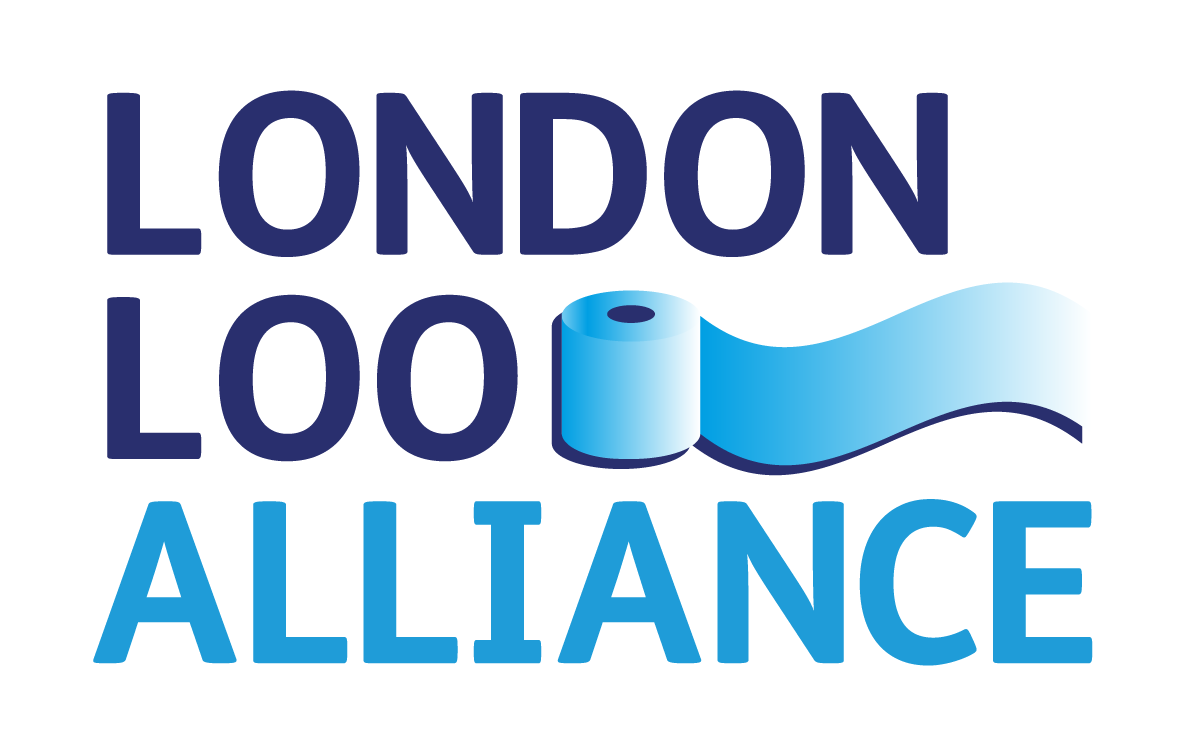BBC Freedom of Information findings
Reality Check: Public toilets mapped
15 August 2018 by Lora Jones & Rachel Schraer BBC Reality Check
For travellers on their summer holidays, where to stop for a toilet break can be a source of worry. Public toilet provision has been declining for a number of years and the BBC has learnt that some UK high streets and tourist hot spots now no longer have any council-run public toilets.
At least 673 public toilets across the UK have stopped being maintained by major councils (unitary, borough, district and city) since 2010, according to figures obtained under the Freedom of Information law. In that time, the UK’s population has been increasing.
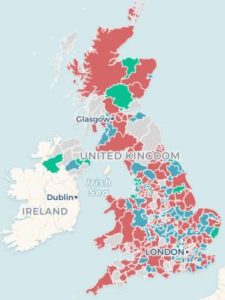
Change in the number of
council-run public toilets, 2010* to 2018
* Where no data for 2010 was available, data for subsequent years up to 2013 has been used instead. Source: BBC FOI requests.
![]()
Data supplied by 376 of the 430 councils contacted by the BBC showed that:
- UK councils stopped maintaining around 13% of public toilets between 2010 and 2018
- But this masks big regional variations – Cornwall Council has stopped maintaining 94% of its toilets, on the Isle of Wight it was 92% and 80% in North Ayrshire
- In 2018 there were 4,486 toilets run by major councils in the UK, down from 5,159 in 2010
- In 37 areas, major councils no longer run any public conveniences
- Highland Council maintains most public toilets (92), followed by Gwynedd (73) and Pembrokeshire (73)

Local authorities are not legally required to provide toilets, meaning they are often closed as councils look to cut costs. A Local Government Association representative said that, while councils were doing everything they could to keep public toilets open, substantial reductions to their budgets have meant they have had to make “tough choices” about public facilities.
The Department of Housing, Communities and Local Government says it encourages councils to keep toilets open to the public since they are a “valuable community amenity”. These findings do not mean there are no toilets available at all, however – in many cases larger councils are shifting responsibility to smaller parish or town councils. Others have been handed to community groups and paid for through fundraising while some councils are relying on the goodwill of businesses to make their toilets available to the public.
Andy McGuinness, campaign manager of Crohn’s and Colitis UK, claims handing the running of facilities over to parish councils in England is only a short-term fix, because it simply passes on the financial pressure. “It takes the upkeep off their books but it’s not sustainable. Parish councils will run them for a couple of years and eventually they’ll probably close anyway,” he said. He added that, without action from government and local authorities, the increasing closures of public toilets in England posed a “very real problem for the millions of people living with continence problems”.
Local councils (such as town and parish councils) get their money from a share of council tax.
Sue Baxter, who chairs the National Association of Local Councils, said smaller councils were increasingly taking over discretionary services such as toilets as budget pressures meant larger councils were finding them harder to provide. But, she said, they faced a dilemma – whether to allow toilets in their local area to close or take them on and face a hefty “toilet tax” in the form of business rates paid on the premises.
What are your rights?
- There is no particular right to access a toilet in publicand local authorities have no duty to provide them
- Businesses that provide toilets for their customers have no legal duty to do so for non-customers
- Workplacesmust provide suitable conveniences for their staff
- Anywhere that offers goods or services to the public must make sure disabled people have equal access to their facilities, including toilets

We asked the 50 councils with the biggest cuts how many had actually closed and how many had been handed over to smaller councils or other groups. Almost all of the 30 that responded had closed at least some, if not all, entirely. Only one council – East Northamptonshire – said its figures didn’t translate to any toilets actually being closed. Several had also handed the running of some toilets to private companies or community groups.
Raymond Martin, of the British Toilet Association, said providing toilets was a public health issue, but it was also about equality and social inclusion. He believes that, while councils have no legal requirement to provide access to public toilets, they do have a “moral responsibility”.
And charity Disability Rights UK says it has increasingly been receiving calls from disabled people reporting that accessible toilets are no longer available.
With these significant reductions in facilities, you might reasonably assume some people will resort to using their wider environment when caught short. So the BBC also asked councils and police forces whether they enforced any laws against public urination, and what had happened to numbers of offences in the same time period. We found that around the country, very few local councils or police forces take action against public urination. Those that do, however, use a range of tools including by-laws, public order offences specifically tackling public urination, and broader offences including indecent exposure, outraging the public decency, littering and harassment.
The London borough of Tower Hamlets, which had one of the biggest falls in the number of offences, said it has focused on “better enforcement” of the rules, which it said has acted as a deterrent. The council added that closures of pubs, clubs and bars had also contributed to the fall in offences.
Data supplied by 388 of 430 major councils and 39 out of 42 police forces in the UK covering the years 2010-2017 revealed that:
- 233 councils and force areas don’t have any by-laws prohibiting public urination
- Of the 180 forces and councils that had by-laws or public order offences against public urination, 112 said they hadn’t enforced them at all during this time period
- For those that did enforce rules against public urination, the number of times they were enforced had fallen in almost all areas
- In total, police forces and councils responding to the request recorded 15,297 offences relating to public urination in 2018, more than halving from 32,668 in 2010
- Where police forces did use public order offences, the numbers were small – fewer than 10 offences in any given year
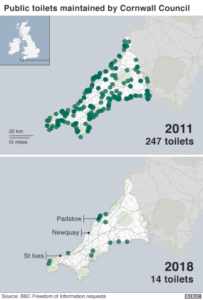
Cornwall’s unitary council saw the number of public toilets it maintains drop over the past five years, from 253 in 2013 to only 14. Over the same time, overall expenditure on toilets was all but wiped out, falling from £4.3m to only £217,000. A council representative said: “We recognise that public toilets are important to residents and visitors alike – but with huge cuts in funding by central government we have been forced, like other local authorities, to review the non-statutory services we provide. “We have now successfully transferred the ownership or management of over 200 public toilets to local city, town and parish councils and local community organisations and businesses. “Only 16 toilets have closed to date.” The council has also started charging for the remaining toilets it runs.
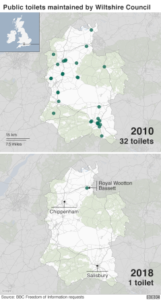
Wiltshire Council now runs only one public toilet on its streets, and another five at park-and-ride sites, in comparison with 32 in 2010.
The council saw its spending on toilets cut by more than £100,000 between the 2016 and 2017 financial years. It said 22 of the toilets were transferred to the control of town and parish councils, and the rest have closed. “We carried out a public consultation exercise in 2015 and the overwhelming response was facilities should be offered to the town and parish councils to run if they felt it was appropriate.”
One of the biggest spenders is the City of London Council. It spent £992,000 on running four public toilets in 2017. In 2010, it spent £1,029,000 on double the number of conveniences. When contacted by BBC News, the council did not comment on why expenditure had remained relatively flat.
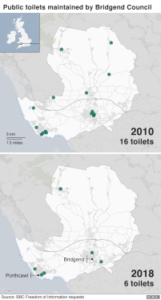
New Forest District Council followed, with an overall expenditure of £877,660 on 24 public toilets and refurbishment work in 2017.
Bridgend County Borough Council in Wales now maintains only six public toilets, down from 16 in 2010. It said that three more toilets were likely to close in the next year, unless they are taken on by town councils, because of budget reductions.
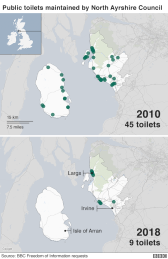
Meanwhile in North Ayrshire, there has been a fall from 45 in 2010 to nine in 2018. The council says five of these were transferred into community ownership and paid for through fundraising, while the rest closed outright.
In Northern Ireland, eight local councils either increased or maintained the same number of public toilets between 2010 and 2018. Fermanagh and Omagh District Council had the highest number of council-run conveniences at 51 in 2018.
Illustrations by Katie Horwich. Maps by Ed Lowther and Prina Shah.














